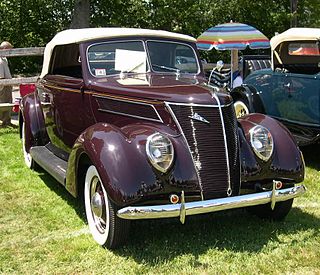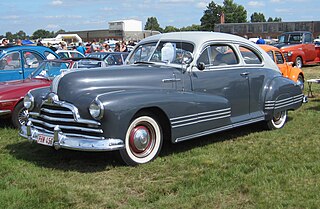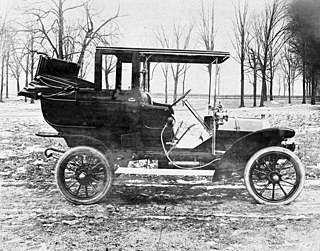
The Series 60 "Special" is a full-size car made by Oldsmobile from the 1939 through the 1948 model years. It was their entry-level model using the GM "A" body platform, giving Oldsmobile an entry level product with more standard features that would be optional on Chevrolet and Pontiac vehicles using the same platform. Initially, the engine size used was the company's flat head 6 cylinder, while senior models would use the flat head 8 cylinder. For marketing purposes, the Oldsmobile Series 60, or the Oldsmobile 66, took advantage of the national highway U.S. Route 66 established in 1926. It was with this generation that all GM vehicles experienced increased width dimensions to accommodate three passengers on the front bench seat and an additional three passengers on rear bench seat installed vehicles. This was accomplished with the deletion of running board thereby adding additional room inside the passenger compartment and upgrading the floor mounted gearshift to a steering column installed transmission gear selector for the Hydramatic automatic transmission.

The Oldsmobile Series 70 is a full-size midrange automobile produced by Oldsmobile between the 1939 and 1950 model years. Oldsmobiles of this time period were in an unusual "middle" position in GM's hierarchy of automobile brands. Chevrolet and Pontiac were the budget priced models, while Buick and Cadillac were the luxury brands. GM would share their "A" body platforms between Chevrolet, Pontiac, and "B" body on Oldsmobile and Buick, while leaving Cadillac on the senior "C" platform. Oldsmobiles were then branded as "luxury level" Chevrolet's and Pontiac's, while Oldsmobiles using the "B" platform were "budget priced" Buicks and Cadillacs.

Buick Estate is a nameplate that was used by the Buick division of General Motors, denoting its luxury full-size station wagon from 1940 to 1964 and from 1970 to 1996. The Estate nameplate was derived from the term country estate in wealthy suburban areas and estate car, the British term for a station wagon.

The Buick Limited was Buick's flagship model line between 1936 and 1942, and, in celebration of GM's Fiftieth Anniversary, a single-year halo car for the Division in model year 1958. Since the 1960s Buick has intermittently used the term "Limited" as a designation denoting its highest level of trim and standard features in its various model ranges.

Viking was a brand of automobiles manufactured by General Motors as a supplement to Oldsmobile division for model years 1929 to 1931 and used the GM B platform. It was shared with the Oakland Model 301 for 1930 and 1931.

The Jeepster is an automobile originally produced by Willys-Overland Motors from 1948 to 1950. It was developed to fill a gap in the company's product line, crossing over from their "utilitarian" proto SUVs and trucks to the passenger automobile market.

The Lincoln Cosmopolitan is a full-size luxury car that was sold by Lincoln from the 1949 through the 1954 model year. All Lincolns were manufactured at Lincoln Assembly, Dearborn, Michigan, while some were sent in "knock-down kits" to regional factories at Maywood Assembly, Maywood, California or St. Louis Assembly, St.Louis, Missouri, and assembled locally.
The Lincoln Custom is a custom limousine and long-wheelbase touring sedan that was built by Lincoln in 1941 and 1942 and the lower level series Lincoln produced in 1955. Initially it was a replacement for the previous Model K Lincolns and earlier luxury cars of the 1920s and 1930s. The body work for the Custom was provided by the factory and came in one appearance and abandoned the previous Model L and Model K of years past of manufacturing only the chassis then a long list of coachbuilders would provide coachwork to the customer's preference. In later years it was simply the base model series.

The Packard Patrician is an automobile which was built by the Packard Motor Car Company of Detroit, Michigan, from model years 1951 through 1956. During its six years in production, the Patrician was built in Packard's Detroit facilities on East Grand Boulevard. The word "patrician" is Latin for a ruling class in Ancient Rome. It was the last "senior level" Packard until production ended in 1958.

The Packard 300 is an automobile built and sold by the Packard Motor Car Company of Detroit, Michigan for model years 1951 and 1952. The 300 represented the upper mid-range Packard model and provided better appointments than the Packard 200 or the Packard 250 models, and replaced the Packard Super Eight. The Packard Patrician 400 became the top level "senior" Packard replacing the Custom Super Eight. The 300 was positioned against the Buick Roadmaster, Cadillac Series 61, Chrysler Saratoga, Frazier Manhattan and Lincoln Cosmopolitan.

The Packard 200 was an automobile model produced by the Packard Motor Car Company of Detroit, Michigan during model years 1951 and 1952. Models in the 200 designation represented the least expensive Packard model range, on the firm's shortest wheelbase, and least powerful 288 cu in (4.7 L) 8-cylinder in-line engine. It replaced the Packard One-Twenty and the Packard One-Ten, and was renamed the Packard Clipper for the 1953 model year.

The Packard Twelfth Series One-Twenty is an automobile produced by the Packard Motor Car Company of Detroit, Michigan, from 1935 to 1937 and from 1939 through the 1941 model years. The One-Twenty model designation was derived from the wheelbase, and it was replaced by the Packard 200.

The Packard Eighteenth Series One-Ten was a range of six-cylinder automobiles produced by the Packard Motor Car Company of Detroit, Michigan during the 1940 and 1941 model years. The One-Ten designation was renamed from the previous Packard Fifteenth Series Six (115-C).The One-Ten shared the wheelbase of the One-Twenty but was given the One-Ten designation to indicate it was the entry level product.

The Ford line of cars was updated in 1937 with one major change — the introduction of an entry-level 136 cu in (2.23 L) V8 in addition to the popular 221 cu in (3.62 L) flathead V8. The model was a refresh of its predecessor, the Model 48 and was the company's main product. It was redesigned more thoroughly in 1941. At the start of production, it cost US$850. The Ford Line bore several model numbers during this period, each related to their respective HP numbers. In 1937, 85 HP cars were known as Model 78 while 60 HP cars were known as Model 74. This changed to Model 81A and 82A respectively in 1938, and Models 91A and 92A in 1939.

The Packard Ninth Series Light Eight Model 900 was an automobile model produced by the Packard Motor Car Company of Detroit, Michigan only during model year 1932. The Light Eight was planned as a new entry model, building off the 1928 Packard Six. It competed in the upper middle-class with makes like GM's Companion Brand LaSalle, Marquette and Chrysler's DeSoto, and the top-level products from Studebaker, Hudson, and Nash. The marketing objective was to add a new market segment for Packard during the depression.

The Pontiac Streamliner is a full-size car produced under the Pontiac brand by General Motors from 1932 until 1952. A mass-produced and popular vehicle, it was a significant luxury car during the recovery from the Great Depression, and during and immediately after the Second World War.

The Oldsmobile Model A was a passenger car manufactured by Oldsmobile for 1907 and it replaced the Model S while it was replaced by the Model M.
The Oldsmobile Series 28, also known as the Autocrat, was a mid-level four seat passenger car produced by GM's Oldsmobile Division for 1911 and 1912. It was based on the top-level Oldsmobile Limited while using a four-cylinder engine, and was manufactured in Lansing, Michigan.

The Oldsmobile Limited was a top-level passenger car produced by GM's Oldsmobile Division in 1910, offered as an upgraded replacement to the Oldsmobile Model Z when it was discontinued in 1909. The Oldsmobile Limited was very large and expensive in comparison to vehicles offered by competitors, and was manufactured in Lansing, Michigan. It was the senior model to the mid-level Oldsmobile Autocrat of which it shared much of its technology while the Autocrat was smaller, and was replaced by the Oldsmobile Light Eight. It was also much larger than GM's lop level brand, the Cadillac Model Thirty which only had a four cylinder engine, and the Buick Model 10 which made the Limited the most expensive vehicle GM offered at the time.

The Packard Six was a series of luxury automobiles built over several generations by Packard from 1913 until 1947. The name was originally used to describe the car in general terms, while Series numbers were initially used and changed every year to denote wheelbases, then the number classification changed as market conditions changed so as to keep competitive with other luxury brands.
























